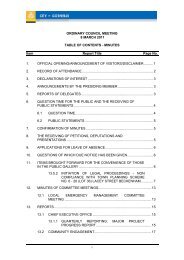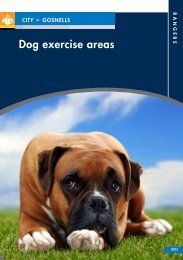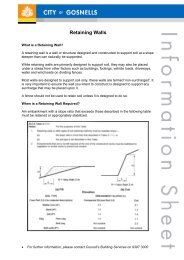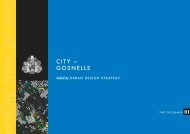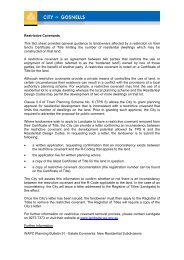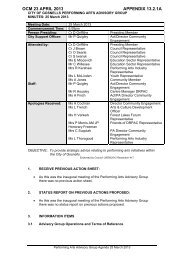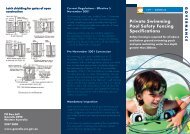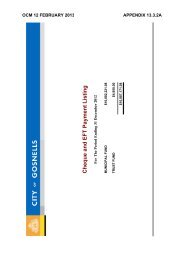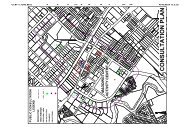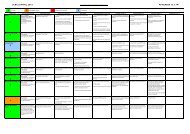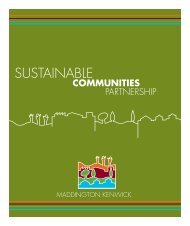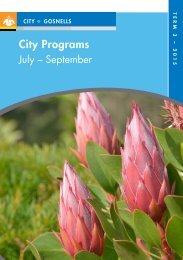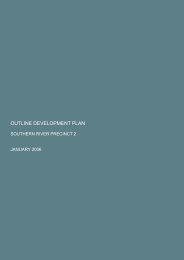Summary - City of Gosnells
Summary - City of Gosnells
Summary - City of Gosnells
Create successful ePaper yourself
Turn your PDF publications into a flip-book with our unique Google optimized e-Paper software.
Methods 21Table 3.2: Bush and Wetland Vegetation Condition (adapted from Government <strong>of</strong> Western Australia, 2000)Code Condition Description <strong>of</strong> VegetationP Pristine No obvious signs <strong>of</strong> disturbance.EVGGDCDExcellentVery goodGoodDegradedCompletelydegradedVegetation structure characteristic <strong>of</strong> the vegetation type remains intact, disturbance affectsindividual species only, and weeds are non-aggressive species.Vegetation structure altered somewhat; obvious signs <strong>of</strong> disturbance, but recovering. Some highlyinvasive weeds may be present at low abundance.Vegetation structure modified significantly (and/or floristic composition somewhat altered) byvery obvious multiple disturbances but ability to regenerate is retained (by, e.g. recruitment <strong>of</strong>native species from abundant soil seed bank).Vegetation structure and floristic composition severely impacted by disturbance; scope forregeneration but not to a state approaching good (sic) condition without intensive managementVegetation structure no longer intact; the area almost completely without native species, e.g.isolated native trees or shrubs over pasture (‘parkland cleared’).TC Totally cleared No native vegetation remaining on site.3.3 Wetland AssessmentThe term ‘wetland’ is defined under the Western Australian Environmental Protection Act, 1986 as ‘an area<strong>of</strong> seasonally, intermittently or permanently waterlogged or inundated land, whether natural or otherwise,and includes a lake, swamp, marsh, spring, dampland, tidal flat or estuary’.Wetlands <strong>of</strong> the Swan Coastal Plain, from Wedge Island in the north to Dunsborough in the south, have beencomprehensively surveyed at a broad scale in Hill et al. (1996). In this survey work (covering approximately362,000 ha <strong>of</strong> wetlands) the wetlands were classified according to the geomorphic wetlands classificationsystem <strong>of</strong> Semeniuk (1987) and Semeniuk and Semeniuk (1995), mapped and evaluated for managementcategory. This survey forms the basis <strong>of</strong> the current Department <strong>of</strong> Environment and Conservation SwanCoastal Plain Wetlands Datasets and Atlas (DEC, 2008a, 2008b, 2008c). In this electronic dataset, eachwetland has been:• classified and allocated to a Consanguineous Suite (after Semeniuk, 1987);• given a unique number that is known as a Unique Function Identifier (UFI); and• allocated to a management category viz. Conservation Category Wetland (CCW), Resource EnhancementWetland (REW) or Multiple Use Wetland (MUW). These management categories are defined in theevaluation section (3.3.3) below.The Swan Coastal Plain Wetlands Dataset is recognised and endorsed as a guide to planning and decisionmaking by all relevant agencies in Western Australia, including representatives <strong>of</strong> the Western AustralianDepartment <strong>of</strong> Environment and Conservation, Western Australian Department <strong>of</strong> Planning andInfrastructure, Western Australian Department <strong>of</strong> Agriculture and Food, local government and communityconservation groups.The SCP Wetlands Dataset is maintained and updated, when required, by the Western Australian Department<strong>of</strong> Environment and Conservation. These updates are only carried out after rigorous assessments based onwell-documented, scientific evidence and are usually related to the scale <strong>of</strong> the mapping and the provision <strong>of</strong>additional biological data (DEC, 2007). The wetland mapping carried out by Hill et al (1996), and other datacontributing to the SCP Wetlands Dataset, was at a scale <strong>of</strong> about 1:25,000. In this mapping, small elevationdifferences were beyond the scale <strong>of</strong> the mapping but may contribute to the reclassification <strong>of</strong> wetlands (orparts <strong>of</strong> wetlands) as reliable data become available at finer scales. There are also sometimes smalldiscrepancies between the broad scale at which the dataset was originally captured and the finer scales atwhich this dataset can now be viewed. Biological data are <strong>of</strong>ten valuable in recognising additionalconservation values in the wetlands mapped in the SCP Wetlands Dataset.DEC (2007) outlines some <strong>of</strong> the information required to assess requests to modify the dataset. Essentiallythe collection <strong>of</strong> such information requires wetland identification, wetland delineation, wetland classificationTauss, C. and Weston, A.S. (2010). The flora, vegetation and wetlands <strong>of</strong> the Maddington-Kenwick Strategic Employment Area.A survey <strong>of</strong> the rural lands in the vicinity <strong>of</strong> the Greater Brixton Street Wetlands. Report to the <strong>City</strong> <strong>of</strong> <strong>Gosnells</strong>, W.A. Version 18.04.10



